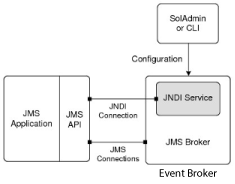Solace JMS API Overview
The Solace Messaging API for JMS allows Java applications to access an event broker using the standard JMS Application Programming Interface (API). JMS provides a common way for Java applications to create, send, receive, and read an enterprise messaging system's messages. For detailed information on JMS, refer to the JMS specification available at the Oracle Web site.
Solace JMS API Programming Paradigm

The Solace JMS API is comprised of the following components:
- Solace JMS API
The Solace JMS API uses the standard JMS interface to provide JMS service for Java-based applications through Solace products.
- Solace event broker
An event broker acts as the JMS broker for the JMS client. As such, it provides access control, message routing, selecting, and filtering.
An event broker can also provide Java Naming and Directory Interface (JNDI) service, which allows JMS clients to perform JNDI lookups and object binding.
Solace products can support multiple event brokers, each operating in its own JMS domain.
- SolAdmin
The SolAdmin application is an administration tool that allows administrators to bind event broker objects (such as connection factories, topics, and queues) to JMS objects, which are then stored in the JNDI store. Administrators can use SolAdmin or the Command Line Interface (CLI) to configure and monitor the JMS objects.
You can use the Solace JMS API to provide messaging service in Java Platform Enterprise Edition (Java EE) application server environments. For more information, refer to Using Solace JMS API in JEE Environments.